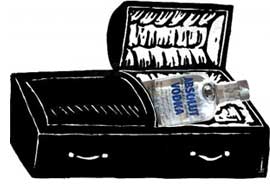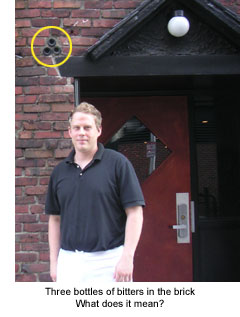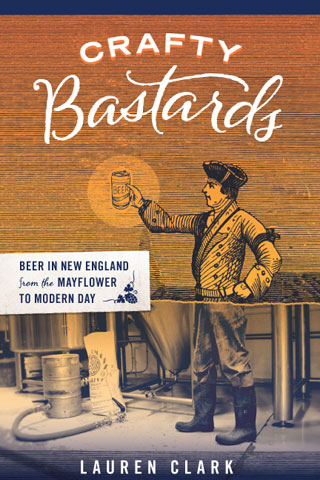August 31st, 2006
 If you’ve been to No. 9 Park (see Best Boston bars), you’re familiar with the restaurant’s cocktail “flights,” three mini-cocktails served at the same time and based on a particular theme. The current offering, Flight of Heraldry ($14), features three great Italian spirits: the bitter liqueurs Aperol and Campari and the vermouth-like Punt e Mes. Everybody’s heard of the bright red, astringently bitter Campari, and Punt e Mes is showing up in more and more bars lately, but Aperol is little known outside Italy. It’s sweeter than Campari, is a beautiful coral color, and has a mild bitterness and a pleasant orange note.
If you’ve been to No. 9 Park (see Best Boston bars), you’re familiar with the restaurant’s cocktail “flights,” three mini-cocktails served at the same time and based on a particular theme. The current offering, Flight of Heraldry ($14), features three great Italian spirits: the bitter liqueurs Aperol and Campari and the vermouth-like Punt e Mes. Everybody’s heard of the bright red, astringently bitter Campari, and Punt e Mes is showing up in more and more bars lately, but Aperol is little known outside Italy. It’s sweeter than Campari, is a beautiful coral color, and has a mild bitterness and a pleasant orange note.
No. 9 Park bartenders Ryan McGrale and John Gertsen invented a delicious, Aperol-based cocktail for the Flight of Heraldry: equal parts Beefeater gin, Aperol, and Cinzano dry vermouth with a spray of lemon peel. They call it the Contessa — as in wife of Count Negroni. The Count may or may not have had a wife, but he did pour a shot of gin in his Americano (Campari, sweet vermouth, splash of soda, orange peel) about a century ago and thus gave birth to one of the great bitters-based drinks, the Negroni, which lost the splash of soda somewhere along the way and is the only previously established cocktail in the No. 9 flight. (According to the New York Times’ latest Style magazine, “Negroni is the new mojito.” If only.) The third drink in the flight is another McGrale-Gertsen invention, the Patrician, which they named after the Count’s imagined “bitter laborer.” It’s equal parts Beefeater, Cointreau, and Punt e Mes and is actually on the mellow side compared to the Negroni. The Contessa’s the more delicate of the three but has a definite bite. I drank these three exquisite cocktails before a delicious plate of truffled gnocchi and felt like a contessa myself.
Permalink | No Comments | Filed under Bitters, Boston bars, Cocktails, Gin |
August 29th, 2006
 Remember how it was cool in the 1980s to be seen with a bottle of Corona in hand and, a little later, a bottle of Red Stripe? Now that those imports from Mexico and Jamaica, respectively, have gone mainstream with TV advertising, a new brand of tropical swill is poised to accessorize the hand of the bargoing hipster: Prestige lager, the national brew of Haiti.
Remember how it was cool in the 1980s to be seen with a bottle of Corona in hand and, a little later, a bottle of Red Stripe? Now that those imports from Mexico and Jamaica, respectively, have gone mainstream with TV advertising, a new brand of tropical swill is poised to accessorize the hand of the bargoing hipster: Prestige lager, the national brew of Haiti.
Other than being unknown, Prestige has several features that lend it cred in the eyes of the beer-drinking vanguard. First, the bottle: like Corona and Red Stripe, the label is painted right onto the glass, which lends a kind of retro cachet. Prestige’s simple, two-color banner and brown, short-necked bottle — similar to Red Stripe’s packaging — also place it high on the retro-meter.
Second, while Corona and Red Stripe evoke images of kicking back in a friendly, quasi-primitive paradise, Prestige only makes you wonder: could I drink this on a beach in Haiti without getting robbed or shot? In other words, while Corona and Red Stripe have slid into the frat-boy, middle-manager demographic, Prestige is for those who live on the edge.
Third, it doesn’t hurt that Prestige is actually a decent light lager whose drinkability doesn’t depend on a wedge of lime. Named Best American Lager in the 2000 World Beer Cup, it is dry and balanced and doesn’t have that adjunct (corn or rice) starchiness found in a lot of macro lagers (though it is brewed with a substantial amount of another adjunct, sugar). Like other beers in this style, it’s good for washing down bold foods. I first tried it with a hot, curried goat stew at Green Street. Next, I brought a six-pack to a feast of takeout barbecue from Soul Fire in Allston. I’ll be the first to admit that a Michelob would’ve done the trick on either of these occasions. But it sure wouldn’t have made me look as cool.
Check out the Brasserie Nationale d’Haiti website for another reason that Prestige has hipster cred: its way politically incorrect advertising image of a healthy-butted woman in a white thong.
Permalink | No Comments | Filed under Beer |
August 24th, 2006
 Continued from part 1.
Continued from part 1.
It’s not that I shun vodka entirely. What else am I going to put in my Bloody Marys? I don’t get all huffy when I order a Martini and the bartender asks, “Vodka or gin?” Vodka’s a fact of life. I’m cool with it. Hell, I stock it in my bar at home and serve it at cocktail parties.
What I’m not cool with is that eight out of 10 drinks on most cocktail menus around Boston are vodka-based. These menus offer what appears to be a great variety of options, which is true if you’re looking for one-dimensional fruit and candy flavors. Where are the more complex, more adult mixed drinks? Where is the whiskey, the gin, the vermouth, the Benedictine? They’re behind the bar alright, but few bartenders know how to make cocktails with them (the few who do are among Boston’s best bartenders, of course).
Vodka’s dominance reminds me of the beer market 25 years ago. The only beer style available was light lager, be it Bud or Heineken. Classic styles like India pale ale and stout were relics of pre-Prohibition days or the Old World. The emergence of craft beer and the growth of imports changed that. Now, when you go out drinking in Boston, any two-bit bar has, at the very least, Harpoon, Guinness, or Sam Adams on tap. Bud is still king (and still really good ice cold out of the can), but it and its pale, fizzy brethren are no longer our only options, thank god.
How did vodka come to drown out other spirits? When a new “cocktail culture” emerged in the early to mid-nineties (Remember? You bought a few of those lounge compilations Rhino Records put out?), it might have seemed to cocktail connoisseurs that everyone would soon rediscover vintage mixtures like Sazeracs and Hemingway Daiquiris. No such luck. In Vintage Spirits & Forgotten Cocktails (2004) Ted “Dr. Cocktail” Haigh offers a colorful scenario of what went down:
“A food and beverage manager (hypothetically) says: ‘This new generation of drinkers…are nostalgic for their vision of the 1950s martini parties they’ve seen in old movies…Only problem is, it’s likely none of this crowd has actually ever had a real martini, and I bet if they did, it would knock ’em on their ass. WAY too strong. They’d run away screaming. So I say this: let’s mix a little vodka and some liqueur, shaken and strained in a stemmed cocktail glass, and call it a fill-in-the-blank Martini.'”
Enter the Cosmopolitan, the poster child of the modern cocktail. Thanks to Sex and the City, this insipid pink drink (vodka, orange liqueur, splash of cran) reached an undeserved level of fame and inspired many spinoffs. It was like Paris Hilton in a glass.
Finally, there was the explosion of vodka brands on the market. There are, like, 92 varieties of vodka on the shelf of a typical liquor store. Their sleek, frosted bottles evoke purity and sophistication, which appeals to a lot of people who a) had a bad experience with tequila in college and believe that vodka’s somehow better for them, and b) think that ordering a “Goose, rocks,” in a bar makes them look cool.
It’s inescapable: vodka is everywhere, and its popularity isn’t going to die down anytime soon. But there are rumblings that drinkers are looking for something new. And just as microbrews came to the rescue of beer drinkers looking for bolder flavors 25 years ago, some bartenders are rebelling against the blandness of “fill-in-the-blank Martinis” by reviving forgotten recipes for truly sophisticated drinks — call them craft cocktails — and people aren’t running away screaming.
Stay tuned for part 3.
Permalink | No Comments | Filed under Boston bars, Cocktails, Vodka |
August 20th, 2006
Established: 2006 (1933)
Specialty: Cocktails
Prices: Moderate
Atmosphere: Gritty on the outside, cool on the inside. Restaurant workers hang out here on their night off — always a good sign — joining foodies, yuppies, and hipsters for consistently great food, top-notch bartending, and an unpretentious attitude. See Best Boston bars for address and contact info.

You might think that ranking a merely eight-month-old bar among Boston’s best is jumping the gun a bit, but this Central Square gem has so much going for it — not least of which is that history is on its side. Green Street operates under Cambridge’s oldest continuing liquor license, issued in 1933.
No matter how much you loved the former Green Street Grill, with its red vinyl seating and tongue-searing, Caribbean food, you have to root for the new Green Street (yes, just Green Street). The cooking, recently taken over by Pete Sueltenfuss (formerly of Eat and Eastern Standard), still rocks, and the vibe is still that of a hopping neighborhood bar. Most important, some of the best bartenders in greater Boston work here. They handle a crowd like experienced circus trainers while deftly executing an ever-rotating menu of vintage cocktails. Green Street’s complete, “A to Z,” drink menu features lots of rum-and-fresh-fruit-juice concoctions, as well as classics like the Iceberg (Plymouth gin, Ricard, mint, shaved ice) and the Phipp’s Fizz (Old Overholt rye, fresh lemon juice, Angostura bitters, ginger beer). Prices average $7-$8. Compare that to $10-$12 for far inferior, flavored vodka ‘tinis in most Boston bars.
Permalink | 1 Comment | Filed under Boston bars, Cocktails |
August 9th, 2006
 Bartender profile
Bartender profile
Dylan Black was a Central Square ruffian who started busing tables on the other side of Cambridge, at Upstairs on the Square, when he was 17. He worked his way up the ranks in various restaurants to waiter, bartender, and, finally, bar manager before coming back to his old ‘hood and buying this beloved, old institution in January 2006. He has maintained the quality of food for which the former Green Street Grill was known. More importantly, he and his crack team of bartenders from among Boston’s best have improved the variety and quality of drinks.
Dylan is unabashedly excited to be running his own place, and his good vibe is infectuous as he greets everyone who walks in the door. But he’s casual and doesn’t overdo it. He’s like that cool kid in high school who threw the best parties by somehow attending to everyone’s liquid, musical, and social needs while being completely at ease and enjoying a few games of quarters.
If you catch Dylan during a lull in business, ask him to mix you a Daisy Black (Old Overholt rye, fresh lemon juice, honey syrup) — an homage to his great grandfather’s bartending nickname — and tell you about the history of the establishment. You’ll learn that Green Street has Cambridge’s oldest operating liquor license, issued in 1933, that the original proprietor saw fit to embed three bottles of Angostura Bitters in the brick outside the front door (see photo above), and that there is a “huge” old sign in the attic for Charlie’s Tap, which occupied this space in the 1940s. With a glint in his eye, Dylan muses over “what has been going on in this room before me.”
Hometown
Cambridge, MA.
Past bartending jobs
Redbones, B-Side Lounge, Chez Henri.
First drink you ever had
A Foster’s “oil can.”
Favorite bar in Boston other than your own
Reggie’s bar at the Blue Room.
The drink you most like to make
Negroni. A perfectly balanced cocktail full of flavor.
The drink you least like to make
White Russians in a pint glass.
What you drink at the end of your shift
Cold beer or the open wine from the shift.
If I weren’t a bartender, I’d be…
Making license plates for the Commonwealth of Massachusetts.
A bartender’s best friend is…
A great chef.
A bartender’s worst enemy is…
A drunk chef.
People drink too much…
Olive juice.
People don’t drink enough…
Water.
Drink for a hot summer day
Iceberg (1 1/2 oz Plymouth gin, 1/2 Ricard, shaved ice, sprig o’mint).
Drink for a cold winter night
Belle & B (1 1/2 oz brandy, 1/2 oz Belle de Brillet in a snifter).
The best thing about drinking in Boston
Drinking on the Charles. I love to drink along the River, on any of the benches, under any of the bridges, I don’t care, I love the River!
The worst thing about drinking in Boston
The cops may arrest you for drinking on the Charles.
Permalink | 1 Comment | Filed under Bartenders |
 If you’ve been to No. 9 Park (see Best Boston bars), you’re familiar with the restaurant’s cocktail “flights,” three mini-cocktails served at the same time and based on a particular theme. The current offering, Flight of Heraldry ($14), features three great Italian spirits: the bitter liqueurs Aperol and Campari and the vermouth-like Punt e Mes. Everybody’s heard of the bright red, astringently bitter Campari, and Punt e Mes is showing up in more and more bars lately, but Aperol is little known outside Italy. It’s sweeter than Campari, is a beautiful coral color, and has a mild bitterness and a pleasant orange note.
If you’ve been to No. 9 Park (see Best Boston bars), you’re familiar with the restaurant’s cocktail “flights,” three mini-cocktails served at the same time and based on a particular theme. The current offering, Flight of Heraldry ($14), features three great Italian spirits: the bitter liqueurs Aperol and Campari and the vermouth-like Punt e Mes. Everybody’s heard of the bright red, astringently bitter Campari, and Punt e Mes is showing up in more and more bars lately, but Aperol is little known outside Italy. It’s sweeter than Campari, is a beautiful coral color, and has a mild bitterness and a pleasant orange note. Remember how it was cool in the 1980s to be seen with a bottle of Corona in hand and, a little later, a bottle of Red Stripe? Now that those imports from Mexico and Jamaica, respectively, have gone mainstream with TV advertising, a new brand of tropical swill is poised to accessorize the hand of the bargoing hipster: Prestige lager, the national brew of Haiti.
Remember how it was cool in the 1980s to be seen with a bottle of Corona in hand and, a little later, a bottle of Red Stripe? Now that those imports from Mexico and Jamaica, respectively, have gone mainstream with TV advertising, a new brand of tropical swill is poised to accessorize the hand of the bargoing hipster: Prestige lager, the national brew of Haiti. Continued from
Continued from 
 Bartender profile
Bartender profile